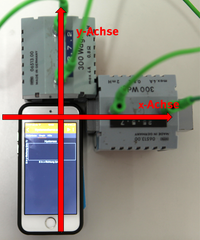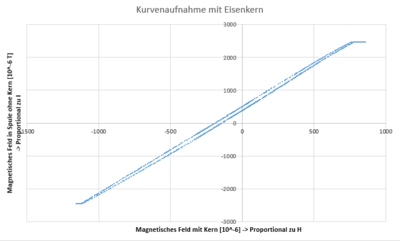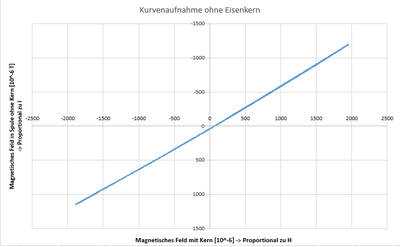Hysteresis curve of an iron core
| Experiment | Hysteresis Curve of an iron core |
|---|---|
| Category | Magnetism |
| Used sensors | magnetometer |
This experiment enables your smartphone to qualitatively measure the hysteresis curve of an iron core. The iron core is sitting inside a coil. By running a current through the coil the iron core is magnetized. When plotting the current running through the coil against the magnetic field of said coil, a hysteresis effect becomes visible. The current is indirectly measured by the magnetic field of a second coil without iron core, set on a different axis.
Contents
Requirements and experimental material
- smartphone (with Phyphox and magnetic sensors)
- 2 coils (e.g. 300 windings)
- iron core (non-folded)
- cross switch
- adjustable power supply (current continuously adjustable)
- laboratory cables
Setup
To make the experiment work properly the right setup is crucial. The coils must be placed in line of the magnetic sensor of the smartphone (wherever it may be built in) and as near as possible to them. The used current must also be chosen in a way that the sensors don't become saturated:
1. Find the position of the magnetic sensor in your smartphone:
The "Calibration" page can be used for this part. Connect both coils in series to the power supply and position them around the smartphone aligned to the x- and y-axes. Turn the power supply to a low current (so that the sensors won't be damaged) and move the coils around to find the exact position of the magnetic sensor. As an example, figure 1 shows the position of the sensor in an Iphone SE and the corresponding axes of it.
Now that the position of the sensor is found, place the coils pointing towards it (in its respective axis) and position them as near as possible to the smartphone. The smartphone might have to be elevated for optimal positioning.
2. Calibrate the setup:
After optimizing the positions of the setup the maximal current must be chosen. Open the "Calibration" page again and slowly increase the current. Choose a maximal current I_max in which no axis of the sensor is saturated (visible plateau altough the current is increasing).
3. Start the experiment:
Now the measurement can finally start. It is recommended to use the experiment remotely - this way the data is visible a lot better. Also, the analysis of the data points via a seperate program like Excel is recommended.
1. Go to the page "Graph" and click the Start-Button.
2. Increase the current up to the maximal current I_max.
3. Wait a few seconds for the iron core to be fully magnetized.
4. Decrease the current to 0, quickly use the switch and increase it back to I_max. (By switching the current is now -I_max)
5. Repeat 3.
6. Repeat 4.
7. Stop the measurement before (!) turning of the powersupply (-> power spike).
Analysis
The graph should now show a distinct curve, which shows a hysteresis effect. Figure 3 shows an example of what can be expected. The difference to the curve without the iron core can be shown by simply taking out the iron core and repeating the experiment. This is shown in figure 4.
Problems and resolutions
Saturation: In case of the Iphone SE (I can only make assumptions about different smartphones) the sensor is saturated at about 2200 µT. Every measurement above this will still be measured at 2200µT. It is also possible to damage the sensor by going above this limit.
Positioning:
In case of the used Smartphone the positioning is rather easy. With the sensor being positioned in the very top right, both coils can be put in the very vicinity of the sensor. Other positions might result in different results.
It is crucial to put the coils as near as possible to the sensor since the magnetic fields of the coils are in no way linear. With the coils being farther away from the sensor the distinction between the two magnetic fields becomes evermore troublesome.
Offset:
In the tested experiments there was always a distinct offset visible, which can't be account for by the magnetic field of the earth only. Since it is a general offset and only a qualitative measurement is wanted, it was not investigated any further.
Speed:
The speed in which the current is increased and decrease is also crucial for the experiment since the hysteresis of an iron core is rather weak. It is therefore recommended to try and test the experiment with different speeds. Since it might vary a lot on which iron core is used no general statement can be made at this point.
phyphox file
Stand 15.05.2017: File:Hysteresekurve eines Eisenkerns aufnehmen.phyphox



